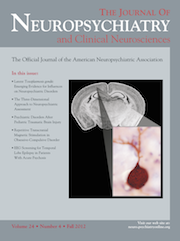Rhabdomyolysis in a Patient on Aripiprazole With Traumatic Hip Prosthesis Luxation
To the Editor: Aripiprazole is a novel atypical antipsychotic drug.1 The association between aripiprazole administration and rhabdomyolysis has recently been described.2 Here, we report a case of rhabdomyolysis in an elderly woman on neuroleptic treatment, including aripiprazole, after traumatic hip prosthesis luxation.
Case Report
An 87-year-old woman with hypertension, chronic renal failure, and depressive syndrome with recent onset of manic episodes, presented at our Emergency Department for pain and functional impairment at her right lower limb after an accidental fall. Consciousness and vital signs were normal. Blood tests showed elevated levels of creatine kinase (21,662 IU/l) and signs of renal failure. Volume-expansion therapy and intravenous administration of furosemide and sodium bicarbonate were immediately started. The radiological examination evidenced a right hip prosthesis luxation. After an unsuccessful attempt at closed reduction, the patient was admitted to the trauma ward of our medical center. The patient had been on neuroleptic drugs, including clozapine and valproate, for several years. A few months earlier, she was also prescribed oral aripiprazole (15 mg qd). Creatine kinase levels increased up to 27,621 IU/l 24 hours later, while renal function continued to deteriorate. No signs of encephalopathy, muscular rigidity, hyperthermia, or autonomic dysfunction were present, thus excluding a neuroleptic malignant syndrome (NMS). Since aripiprazole had been the last neuroleptic drug to be added, its administration was discontinued. Subsequent blood tests evidenced a progressive decrease of creatine kinase levels, with concomitant amelioration of renal function. Normal creatine kinase levels were achieved 12 days after aripiprazole discontinuation. The patient underwent open reduction of the prosthesis luxation and was subsequently transferred to a rehabilitation clinic.
Discussion
The pathophysiology of rhabdomyolysis is multifaceted; however, an alteration of intramyocyte calcium homeostasis is usually involved.3 When the electrochemical gradient across the sarcolemma is disrupted, a massive influx of extracellular calcium into the sarcoplasm occurs. Calcium overload eventually triggers the cell death cascade.3
In our case, rhabdomyolysis could not be exclusively attributed to the muscle trauma, which was relatively mild. We therefore hypothesized that medications might have contributed to its development. This was confirmed by the normalization of clinical and laboratory parameters after the discontinuation of aripiprazole. The association between aripiprazole administration and rhabdomyolysis independent of NMS has recently been reported in a schizophrenic young man.2 After 30 days of aripiprazole administration (15 mg orally qd), the patient presented with severe muscle weakness associated with elevated serum creatine kinase levels and myoglobinuria. Laboratory and clinical parameters normalized after aripiprazole discontinuation and high-volume intravenous therapy.
A possible mechanism by which aripiprazole induces rhabdomyolysis is through its antagonistic activity on skeletal myocyte 5-HT2A serotonin receptors, which are required for excitation–contraction coupling and energy homeostasis.4 Our hypothesis is that the inhibition of 5-HT2A receptors by aripiprazole could have amplified the traumatic muscular damage by compromising myocyte energy metabolism and calcium homeostasis.
Future studies are warranted to establish the safety profile of aripiprazole, especially in multimorbid older patients. In the meantime, the possibility of developing rhabdomyolysis should be taken into account in patients on aripiprazole who have suffered a recent musculoskeletal trauma.
1 : Aripiprazole: a novel atypical antipsychotic drug with a unique and robust pharmacology. Neuropsychopharmacology 2003; 28:1400–1411Crossref, Medline, Google Scholar
2 : Aripiprazole-associated rhabdomyolysis in a patient with schizophrenia. J Neuropsychiatry Clin Neurosci 2011; 23:E51Crossref, Medline, Google Scholar
3 : The syndrome of rhabdomyolysis: pathophysiology and diagnosis. Eur J Intern Med 2007; 18:90–100Crossref, Medline, Google Scholar
4 : Identification and localization of a skeletal muscle serotonin 5-HT2A receptor coupled to the Jak/STAT pathway. J Biol Chem 1997; 272:14825–14829Crossref, Medline, Google Scholar



